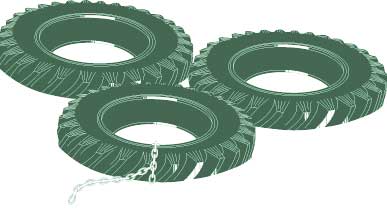Other Trail Grading Equipment You Can Pull With an ATV
Our field contacts provided information about several other techniques and equipment they had tried or were using for OHV trail maintenance. Here are some grading accessories you can tow with an ATV.
Tine HarrowThe tine harrow (Figure 15) is best used for finish work, smoothing the trail surface once it has been leveled by other means. It has smoothing power but not much cutting power. It does not provide any compaction.

Figure 15—This tine harrow
or pasture drag can be pulled with the tines
down for scarification, or the harrow can be flipped over for final smoothing.
Old truck tires (Figure 16) can be filled with concrete for added weight. Large truck tires are heavy enough without extra weight. Tires, sometimes one behind another, are inexpensive and help to smooth the trail surface. They have little cutting ability to remove whoop–de–doos, and also push tread–surfacing material to the sides of the trail—a disadvantage.

Figure 16—Tire drags with
various configurations of one,
two, or three tires help to provide a smooth, finished surface to the trail.
We also heard about using three tire halves (cut like you would slice a bagel, using a reciprocating saw), bolted together in a triangle and dragged with the cut face down.

Ralph Rawlinson sent information of good success with two inexpensive drags used on the Dixie National Forest in Utah. Both can be pulled with ATV's. The base of the rectangular drag (Figure 17) is 5 feet 8 inches (1.8 m) long, and 4 feet (1.2 m) wide. The perimeter is 3–inch (7.6–cm) angle iron, the middle bar is 3–inch (7.6–cm) channel iron.

Figure 17—This rectangular
drag from the Dixie National
Forest is inexpensive and effective.
The V–Drag (Figure 18) is basically fabricated out of two 67–inch (170–cm) pieces of 4–inch (10–cm) channel iron. It is 54 inches (137–cm) wide. This design sidecasts the trail material rather than pulling it into the center, an undesirable feature.

Figure 18—The V–shaped
drag moves
material to the side of the trail, a disadvantage.
Another grader prototype from the Deschutes National Forest features cutting blades perpendicular to the trail instead of angled (Figure 19). This particular configuration left a small berm of material on either side of the grader. When a pass with the perpendicular cutting drag was followed by a pass with the Deschutes Trail Drag, and then a pass with the tine harrow, trails were left in good shape. Dick Dufourd does not plan to build another perpendicular cutting drag. The Deschutes Trail Drag, with its angled blades and electric actuator, is far superior.

Figure 19—Early prototype
of a drag with cutting blades perpendicular
to the trail. It needs significant changes to make it work better.
This basic lawn roller (Figure 20) can be pulled by an ATV. It smooths the surface but provides no compaction. We do not recommend it for trail maintenance.

Figure 20—This garden
variety lawn roller did not provide
enough benefit to make it worthwhile for trail grooming.
Pulling it is a waste of time.

